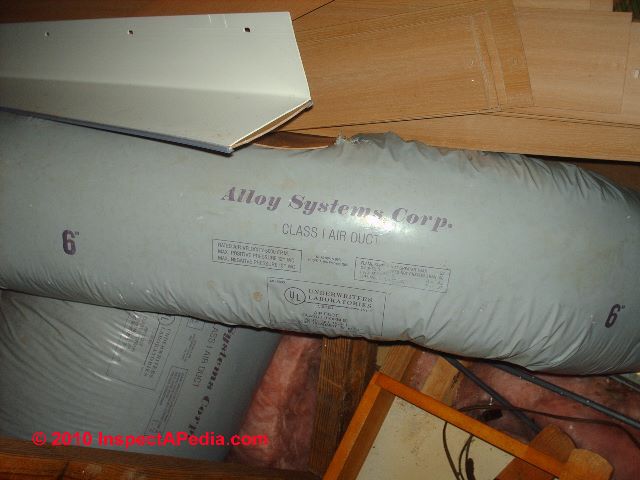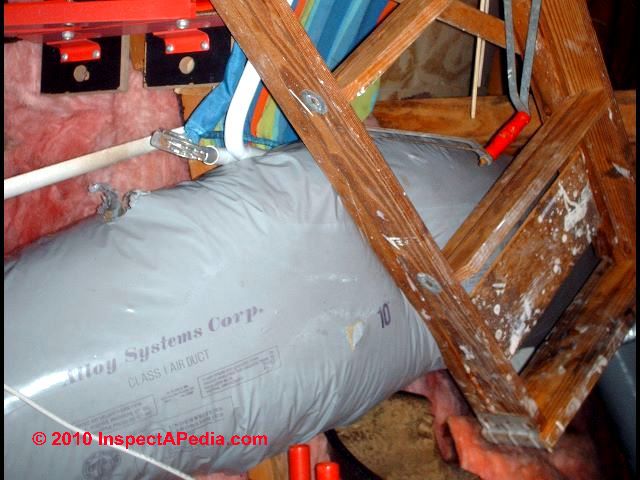 Alloy Systems™ Gray Flex Duct Deterioration & Failures
Alloy Systems™ Gray Flex Duct Deterioration & Failures
- POST a QUESTION or COMMENT about flexible HVAC duct deterioration, leaks, and problem products
Gray HVAC flex-duct failures:
This article explains Alloy Systems™ brand gray flex duct failures that appear as loss of the gray plastic duct covering due to brittleness that appears to be caused by exposure to heat (such as in a hot attic), with references to product failures by several manufacturers of flexible duct work,
including ATCO™ Ruber Products, Alloy Systems™, Goodman™ flex duct, Owens Corning™ flex duct, Owl™ flex duct.
We believe that none of these defective flex duct products is currently sold (2010) but both may be found in older homes. Note: not all Owens Corning flex duct products share this defect and disintegration problem.
InspectAPedia tolerates no conflicts of interest. We have no relationship with advertisers, products, or services discussed at this website.
- Daniel Friedman, Publisher/Editor/Author - See WHO ARE WE?
ALLOY SYSTEMS™ GRAY FLEXDUCT - Deterioration in Hot Locations

Air conditioning duct system defects include a remarkably wide range of errors, from failure to supply cool air or failure to even circulate air in the building, to health hazards such as use of asbestos material in or on duct work, to very dangerous conditions such as drawing heating equipment combustion gases into the building cooling (or heating) air.
The first field reports we received of gray flex duct disintegration bearing the Alloy Systems brand was in 2010, reported by Eric Van De Ven, a South Florida home inspector.
The Alloy Systems flex duct photos in this article were provided by Mr. Van De Ven and were taken in a South Florida home built in 1984.
The Alloy Systems Corp. flex duct in Mr. Van De Ven's photo (above left) shows the product manufacturer's name.
This article explains Alloy Systems™ brand gray flex duct failures
that appear as loss of the gray plastic duct covering due to brittleness that appears to be caused by exposure to heat (such as in a hot attic), with references to product failures by several manufacturers of flexible duct work, including ATCO™ Ruber Products, Alloy Systems™, Goodman™ flex duct, Owens Corning™ flex duct, Owl™ flex duct.
We believe that none of these defective flex duct products is currently sold (2010) but both may be found in older homes.
Note: not all Owens Corning flex duct products share this defect and disintegration problem.
The loss of the protective plastic covering on flex duct poses several concerns including loss of the duct insulation, increased air conditioning system operating costs, and possibly air leaks out (if supply ducts are damaged) or un-wanted attic debris leaks in (if return ducts are damaged), and in-duct condensation in the HVAC system leading to mold and indoor air quality concerns.

This Alloy Systems gray flex duct or "flex duct" air conditioning duct work material is a defective product.
In hot attic spaces or where exposed to UV light, the plastic of this flexible air conditioning duct material disintegrates leaving its fiberglass insulation exposed to also disintegrate, leak, or possibly blow into the building living space.
Replacement of the duct work is required - a significant expense.
- Thanks to Eric Van De Ven for these photos of Alloy Systems gray flex duct disintegrating in an attic.
Where this duct is found in a building it should be replaced. When a heating or air conditioning flex-duct product has lost its exterior plastic covering the effects are these:
- The cost of heating or cooling the building is increased due to lost insulation:
because the ducts are no longer insulated from the ambient temperature in the attic or crawl space where they are located.
For example, an air conditioning duct passing through a hot attic and missing its insulation will be heated by the ambient attic air, delivering warmer air to the living space than is desired. - The cost of heating or cooling the building is increased due to leaks:
because damaged ducts are more likely to leak, cooled or warmed air intended for the occupied space may be lost in the attic or crawl space where the damaged HVAC ducts are located.
In addition we might see these two indirect problems developing: - Increased circulation of fiberglass particles
from the duct insulation or from building insulation which may be picked up and blown into the building air supply - Mold growth
in the HVAC ducts due to loss of insulation and increased in-duct condensation in some circumstances.
Below at Technical Reviewers & References we include Flexible Air Duct Installation Manuals, standards, guidelines, and contact information for several flexible air duct manufacturers as well as access to Flexible Duct Performance & Installation Standards provided by the Air Diffusion Council.
List of plastic-covered flexible HVAC duct products that appear to deteriorate in hot spaces like attics
Readers concerned with deteriorating plastic and fiberglass-covered flex duct in buildings should see the duct failure reports listed below.
...
...
Continue reading at GRAY FLEXDUCT FAILURES or select a topic from the closely-related articles below, or see the complete ARTICLE INDEX.
Or see these
Recommended Articles
Suggested citation for this web page
ALLOY SYSTEMS FLEXDUCT at InspectApedia.com - online encyclopedia of building & environmental inspection, testing, diagnosis, repair, & problem prevention advice.
Or see this
INDEX to RELATED ARTICLES: ARTICLE INDEX to HVAC DUCT SYSTEMS
Or use the SEARCH BOX found below to Ask a Question or Search InspectApedia
Ask a Question or Search InspectApedia
Try the search box just below, or if you prefer, post a question or comment in the Comments box below and we will respond promptly.
Search the InspectApedia website
Note: appearance of your Comment below may be delayed: if your comment contains an image, photograph, web link, or text that looks to the software as if it might be a web link, your posting will appear after it has been approved by a moderator. Apologies for the delay.
Only one image can be added per comment but you can post as many comments, and therefore images, as you like.
You will not receive a notification when a response to your question has been posted.
Please bookmark this page to make it easy for you to check back for our response.
IF above you see "Comment Form is loading comments..." then COMMENT BOX - countable.ca / bawkbox.com IS NOT WORKING.
In any case you are welcome to send an email directly to us at InspectApedia.com at editor@inspectApedia.com
We'll reply to you directly. Please help us help you by noting, in your email, the URL of the InspectApedia page where you wanted to comment.
Citations & References
In addition to any citations in the article above, a full list is available on request.
- Thanks to Eric Van De Ven, a South Florida home inspector, owner of Magnum Inspections Inc., Phone: (954) 340 6615 e mail: ev@magnuminspections.com for the discovery, reporting, photographs, and reporting of Alloy Systems gray flexduct failures. 04/15/2010.
- Alloy Systems Corp Incorporated: This Alloy Systems (not the companies by similar name that provide computer services or clothing) is or was a private company categorized under HVAC, Ducts, Sheet Metal. The company was located in Melbourne, FL. Established in 1984. Other records indicate an original incorporation year of 1978 depending on the source. Alloy was incorporated in Florida, with this address on record:
6928 Vickie Cir Melbourne, FL 32904-2217 (321) 727-3513, Incorporated by Moren, Patrick J., Alloy Systems Corp. The original Alloy Systems Corp. was incorporated on Friday, May 26, 1978 in the State of FL and is currently not active. Moren, Patrick J. represents Alloy Systems Corp. as their registered agent. - FLEXDUCT LAWSUIT [PDF] Richard T.D. Bethea et als, v. Song Hee Hong, et al, filed may 29, 2009, Jackson Tennessee Court of Appeals, dispute involving the contract for sale of a house. A musty odor was associated with mold contaminated flex duct in the building.
The ductwork could not be cleaned because of its fragility - an Owl-flex duct product. Sellers (correctly) asserted that the ductwork could not be cleaned. The court finding includes the statement that "OWL FLEX ductwork was uncleanable".
The buyers ability to terminate the sales contract was upheld. - Mark Cramer Inspection Services Mark Cramer, Tampa Florida, Mr. Cramer is a past president of ASHI, the American Society of Home Inspectors and is a Florida home inspector and home inspection educator. Mr. Cramer serves on the ASHI Home Inspection Standards. Contact Mark Cramer at: 727-595-4211 mark@BestTampaInspector.com
- John Cranor [Website: /www.house-whisperer.com ] is an ASHI member and a home inspector (The House Whisperer) is located in Glen Allen, VA 23060. He is also a contributor to InspectApedia.com in several technical areas such as plumbing and appliances (dryer vents). Contact Mr. Cranor at 804-873-8534 or by Email: johncranor@verizon.net
- Thanks to Jon Bolton, an ASHI, FABI, and otherwise certified Florida home inspector who provided photos of failing Goodman gray flex duct in a hot attic.
- DESIGN & INSTALLATION of RESIDENTIAL FLEXIBLE DUCTWORK SYSTEMS [PDF] Georgia Department of Community Affairs, 60 Executive Park, NE, Atlanta GA 30329
- (404) 679-4940 - (800) 359-4663 [Also see the installation manuals below at JPL] - original source dca.state.ga.us/development/constructioncodes/publications/1ONE.pdf
"1. This information is intended to assist contractors, installers and code officials in the proper design and installation of flexible ductwork systems. The information presented in this document comes primarily from sources in the International Mechanical Code including referenced standards and Georgia Amendments.
2. It is recommended as a guide that HVAC system documentation, including owner’s manuals, manufacturer’s installation instructions and a sketch of the duct system design that details duct size and approximate duct lengths be provided to the building owner or posted on the air handling unit or furnace. (See sample Duct System Design Sketch). Documentation should also include Manual J calculations." - "Flexible Duct Performance & Installation Standards", Air Diffusion Council, 1901 N. Roselle Road, Suite 800, Schaumburg, Illinois 60195, Tel: (847) 706-6750, Fax: (847) 706-6751 - Email: info@flexibleduct.org - www.flexibleduct.org/ -
"The ADC has produced the 4th Edition of the Flexible Duct Performance & Installation Standards (a 28-page manual) for use and reference by designers, architects, engineers, contractors, installers and users for evaluating, selecting, specifying and properly installing flexible duct in heating and air conditioning systems.
Features covered in depth include: descriptions of typical styles, characteristics and requirements, testing, listing, reporting, certifying, packaging and product marking.
Guidelines for proper installation are treated and illustrated in depth, featuring connections, splices and proper support methods for flexible duct. A single and uniform method of making end connections and splices is graphically presented for both non-metallic and metallic with plain ends."
The printed manual is available in English only. Downloadable PDF is available in English and Spanish. - Owens Corning [Website] Duct Solutions - www.owenscorning.com/ductsolutions/ - provides current HVAC ductwork and duct insulating product descriptions and a dealer locator. Owens Corning Insulating Systems, LLC, One Owens Corning Parkway, Toledo, OH 43659 1-800-GET-PINK™
- "Flexible Duct Media Fiberglas™ Insulation, Product Data Sheet", Owens Corning - see owenscorning.com/quietzone/pdfs/QZFlexible_DataSheet.pdf
"Owens Corning Flexible Duct Media Insulation is a lightweight, flexible, resilient thermal and acoustical insulation made of inorganic glass fibers bonded with a thermosetting resin." - "Flexible Duct Performance and Installation Standards", (3rd ed.) – Air Diffusion Council, 1901 N. Roselle Road, Suite 800, Schaumburg, Illinois 60195, Tel: (847) 706-6750 - Fax: (847) 706-6751 email: Email: info@flexibleduct.org
- HVAC Duct Construction Standards—Metal and Flexible (1995 ed.) – Sheet Metal and Air Conditioning Contractors’ National Association, Inc. (SMACNA)
- J.P. Lamborn Co. [Website] 559-650-2120 / fax 559-650-2112, email: cuserv@jplflex.com - original source for the air duct installation manuals below - http://www.jplflex.com/featured/instructions.asp - note that these FlexDuct installation guides provided by JP Lamborn Co. originate with the Air Diffusion Council - referenced above.
Flexible air duct Installation Instructions for Air Ducts & Connectors without fittings [PDF]
Flexduct Installation Instructions for Flexible Air Ducts & Connectors with fittings [PDF]
Flex duct Installation Instructions for Flex Ducts & Connections using mastic
[PDF]
"Originally founded in 1961, JP Lamborn Co. has grown to become one of the largest producers of insulated flexible duct in the country. With 4 state of the art manufacturing plants strategically positioned across the USA in order to serve a growing national distributor base. The company prides itself in delivering quality, service, innovations and competitive pricing to customers it serves." - International Mechanical Code, 2000 Edition, with 2001, 2004 & 2005 Georgia Amendments
- Manual D—Residential Duct Systems – Air Conditioning Contractors of America (ACCA)
- The Wiki article on UV degradation was at http://en.wikipedia.org/wiki/UV_degradation
- In addition to citations & references found in this article, see the research citations given at the end of the related articles found at our suggested
CONTINUE READING or RECOMMENDED ARTICLES.
- Carson, Dunlop & Associates Ltd., 120 Carlton Street Suite 407, Toronto ON M5A 4K2. Tel: (416) 964-9415 1-800-268-7070 Email: info@carsondunlop.com. Alan Carson is a past president of ASHI, the American Society of Home Inspectors.
Thanks to Alan Carson and Bob Dunlop, for permission for InspectAPedia to use text excerpts from The HOME REFERENCE BOOK - the Encyclopedia of Homes and to use illustrations from The ILLUSTRATED HOME .
Carson Dunlop Associates provides extensive home inspection education and report writing material. In gratitude we provide links to tsome Carson Dunlop Associates products and services.


